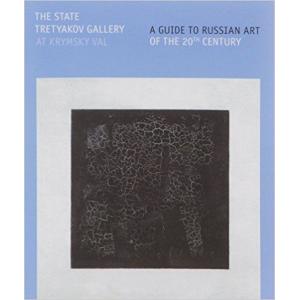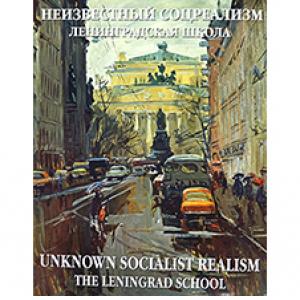Leningrad School of Painting
by Sergei Ivanov and Cathy Locke
This article was written based on the 2012 exhibition of Leningrad School artists – “Without Barriers. Russian Art 1985-2000” – in the Benois Wing at the Russian Museum. The artists in the exhibition had been displaying their work in their apartments for many years, so the opportunity to show their artwork to the public as "Official Soviet Art" on such a prodigious scale was historical. In one of life’s strange coincidences, Sergey Ivanov, author of the book, ”Unknown Socialist Realism, The Leningrad School,” recently approached me regarding selling his beautiful coffee table book in my online bookstore and gifted me with a copy. So I thought I would take the opportunity to share what I have learned and seen from his book. Sergey's book is now available for purchase in our online bookstore.
The Leningrad School refers to both the art institution known today as the Repin Academy of Arts in St. Petersburg and the students who studied there. The term is also used to describe artists who were members of the Leningrad Union of Artists during the period of 1932 to the 1990s, which included approximately 1,200 artists. In 1924 St. Petersburg’s name was changed to Leningrad and in 1991 it was changed back to St. Petersburg. During the height of the Russian Avant-garde Movement, traditional methods of teaching art were lost and the quality of education drastically deteriorated. What had once been known as the Imperial Academy in St. Petersburg was nearly destroyed as a school of painting between the years of 1922 and 1932. The Department of Easel painting was actually closed because it was believed that easel painting was not a progressive form of art. During this time students were allowed to use priceless nineteenth-century masterpieces that were stored at the Academy for their materials!
Steps to return to traditional art education began in Russia with the adoption of Stalin’s decree in April 1932 that dissolved all existing literature and arts organizations to form one unified creative union that dictated all creative output including education. The former Imperial Academy in St. Petersburg was transformed into the Institute of Painting, Sculpture and Architecture and the painter Isaak Brodsky was named its director. On August 2, 1932 the Leningrad Union of Soviet Artists was officially born and ushered in an era of Soviet art. The first chairman was the painter Kuzma Petrov-Vodkin, whose famous painting of a flying red horse became the symbol of the new Soviet Russia. Stalin’s decree marked a clear line in the sand of the revival of art education and a return to realism. From this moment forward the education of future painters was based on the thorough study of drawing, composition, painting and art history. Requirements for applicants became stricter and the old system of master’s workshops was restored. Brodsky, a former student of the great Russian master Ilya Repin, understood the importance of traditional education and his role in this great new revival.
During the 1930s the artists of the Leningrad School painted a variety of subject matter including landscapes and still lifes as well as paintings of greater social significance. On June 22, 1941, academic life was forever changed for these artists with the attack by Germany on Russia. The first train carrying the treasures of the Hermitage collection left Leningrad just nine days after the war broke out. In total over one million priceless artworks were evacuated at the beginning of the war. During the winter blockade of 1941 to 1942 over a hundred Leningrad artists were killed. Many, like Pavel Filonov, died of starvation. In 1942 the Institute and its Secondary Art School were evacuated to southern Russia. During this time these artists painted subject matter that focused on the new heroes of this war.
After the war, students quickly returned to the Institute in Leningrad. Veterans were exempt from all entrance requirements. These new heroes brought with them the air of victory, a love for their country and national pride. This was a turning point in the history of the Leningrad School and Soviet art. Artwork became devoted to the recent war. Paintings depicted optimism, self-reliance and the Russian people’s beauty and moral courage. Portraits of national leaders became very popular. This is the time that the art movement that is known as Soviet Realism was really at its height. In 1957 the first Russian Congress of Soviet artists took place in Moscow. In 1960 the Russian Union of Artists was formed. These two events influenced greater experimentation at the Institute. During this time we see a shift to a more painterly style of painting. The subject matter started to shift, showing new construction and development in the countryside of Russia. Also, “Heroes of the Time” – young scientists, workers, engineers and physicians – all became popular subjects for paintings. The concept of the “psychological portrait,” popular with artists of the late 1800s, came back in vogue.
During the late 1960s and the 1970s the Leningrad School marked a period of artistic maturity. Artists of the school were looking to create socially significant and technically perfect artwork. This period also marks a time when Russian museums increased their buying programs and a new system was set in place where artists actually received advance payments before they began to paint! New exhibition halls were opened and trips abroad became more frequent for these artists. The artists from this school in the 1970s were a different breed than the previous generation. For them the war and post-war hardships were long-gone history. They painted a different set of images; it was a period of creative revival and work with new genres and styles. Works of this period were extremely positive and delightful to look at. When the Soviet Union collapsed in 1991, Leningrad regained its name of St. Petersburg and the government policy of financing art decreased. Artists were left to find their own ways of selling their art. These historical shocks marked the end of the Era of the Leningrad School of Painting in Soviet Art and the beginning of another phase in the history of modern Russian Art. Today the Leningrad School of Painting is an integral part of Russian and World Art history, and its paintings are the pride of the major Art Museums and private collections around the world, including the Russian Museum, the Tretyakov Gallery, MOMA, the Tate Gallery, the Hermitage.

The Book: Unknown Socialist Realism. The Leningrad School
The album contains a substantial collection of works by a large group of painters representing the Leningrad School of Painting. This book is the first inclusive publication on the history of the Leningrad School, one of the brightest and significant phenomena in the Soviet art of 1930-1980 that strongly influenced its contents and development.
The book outlines basic periods of the school's evolution from the period that preceded its formation in the early 1930s up to the early 1990s. Paintings reproduced in the publication belong to large Russian and private collections with some of the works published for the first time. This allows for a renewed and more comprehensive assessment of the art heritage of individual painters and the epoch in general. The publication contains a historical outline, artists' biographies and photographs and an extensive reference section that helps the reader navigate the book materials and provides important historical guidelines. Texts are published in Russian and English.
Number of pages: 450 pages, 343 color plates
Cover: Hardcover
Language: Russian and English
Size: 12.7" tall x 10" wide

























